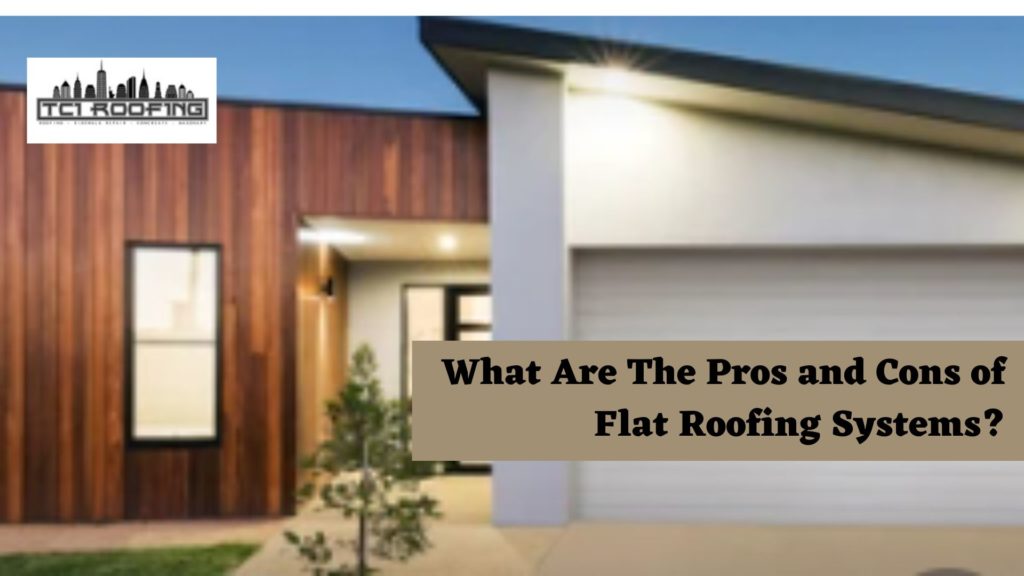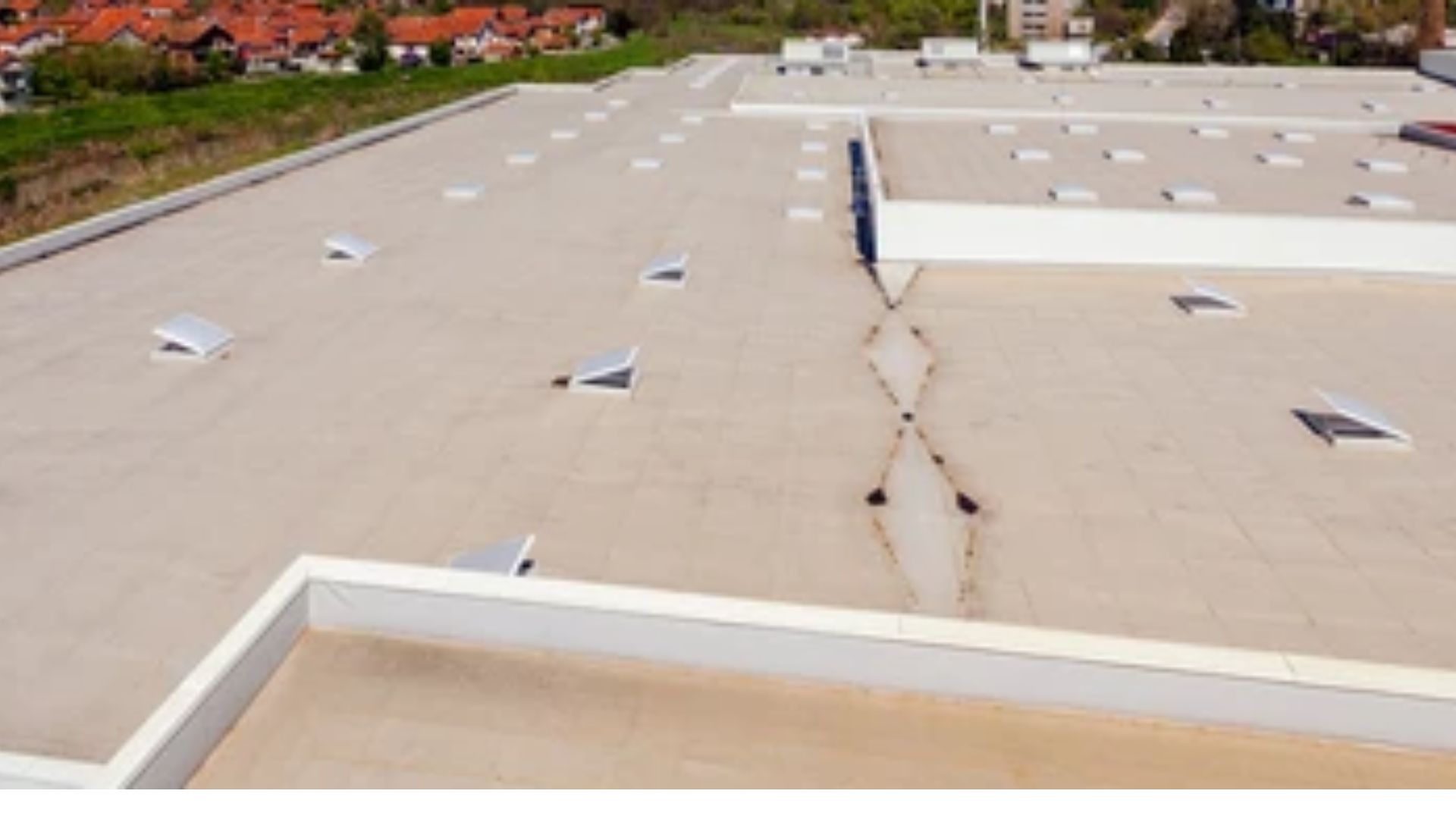Flat roofing systems are where the roof deck is level or nearly level. While there are a few different flat roofs, the most common is the built-up roof (BUR). Other popular styles include single-ply membranes, such as ethylene propylene diene terpolymer (EPDM), thermoplastic polyolefin (TPO), and metal roofs.
Flat roofs and flat roof materials are a preferred option for homeowners and home builders developing new homes because of their distinctive appearance and contemporary aesthetics. As the name implies, a flat roof is positioned horizontally on top of a building with a minor incline.
Why Use a Flat Roofing System?
These are widely utilized in both commercial and residential structures. The most frequently used region is in large structures, like outbuildings. This roofing type, often composed of synthetic rubber and asphalt, slopes between 14 and 12 inches per foot to drain water effectively within flat roof surface.
If you decide to build your own home, you’ll probably need to design your roof. First, determine your needs before deciding between a flat roof and a pitched roof (which has at least two slopes that climb at an angle of more than 10 degrees each to form a crest) (one with a grade of 10 degrees or less).
The challenges and requirements that come with flat roofs are unique. However, here are the main benefits and drawbacks of flat roofing that you should be aware of if you intend to install one on a house or other structure.
What Are The Pros of Using Flat Roofing?
There are several advantages to choosing a flat roof for your home or business:
1. Cost-Effective: Installing a flat roof is often more affordable than installing a pitched roof. This is because fewer materials and labor are required to build a flat roof. Also, since a flat roof is more difficult to fall off than a pitched roof, it is less expensive to insure a company that installs flat roofs. In addition, because flat roofs don’t need the rafters and designed trusses needed for pitched roofs, they are less costly and require fewer materials.
Contrarily, these are typically more expensive than standard roofs because of the additional components that must be installed, such as vapor retarders, insulation, and a cover board, to make the class A fire-rated. Additionally, they don’t need the designed trusses that other pitched roofs do.
2. Simple Installation: Flat roofing installation are easier than pitched roofs. This is because there is less framing and roofing material required. Since a flat roof is easier to install, you won’t have to wait long to move in. Additionally, re-roofing is relatively quick and straightforward if you ever need to make any repairs or even replace your roof. Some work can be finished in less than a day, so you don’t need to block up a significant amount of your schedule to deal with roofers.
3. Easy Maintenance: Flat roofs are easier to maintain than pitched roofs. This is because there are fewer areas that need to be cleaned and repaired.
4. Increased Living Space: Flat roofs can be used to create an additional living space, such as a rooftop deck or garden. A flat roof overcomes the problem of having walls at sharp angles and can create more room. Barriers may reduce living space with pitched roofs, especially those with too many pitches.
5. Environmentally Friendly: Flat roofs can be made from recycled materials, such as rubber and asphalt. They are also easy to recycle at the end of their lifespan. In addition, a flat roof overcomes the problem of having walls at sharp angles and can create more room. Walls may lessen living space with pitched roofs, especially those with too many pitches.
6. Enhanced Aesthetics: Flat roofs have a unique and modern aesthetic that can enhance the curb appeal of your home or business than of the membrane roof and modified bitumen roof.
What Are The Cons of Using Flat Roofing?
There are also several disadvantages to choosing a flat roofing system for your home or business:
1. Limited Lifespan: Flat roofs have a shorter lifespan than pitched roofs. This is because they are more susceptible to sun, wind, and rain damage. In addition, since flat roofs don’t have the drainage system of pitched roofs, standing water can accumulate and lead to leaks.
2. More Susceptible to Leaks: Flat roofs are more susceptible to leaks than pitched roofs. This is because they don’t have the drainage system of pitched roofs. In addition, since flat roofs are more vulnerable to damage from the sun, wind, and rain, they are more likely to develop leaks.
3. Flat roof systems require more maintenance than pitched roofs. This is because they are more susceptible to sun, wind, and rain damage. In addition, since flat roofs don’t have the drainage system of pitched roofs, standing water can accumulate and lead to leaks.
4. Not Ideal for All Climates: Flat roofs are not ideal for all climates. In particular, they are not well suited for areas with heavy snowfall or severe weather conditions.
5. Flat roofs require specialized training to install. This is because they are more complex than pitched roofs and require different skills to install correctly or roof replacement.
If you’re considering a flat roof for your home or business, weigh the pros and cons carefully to decide if it’s the right choice to acquire flat roofing membranes or membrane roofing.
How Much Do Roofing Services Charge For Flat Roof Repair?
The average cost for flat roofing services is $500. However, the cost of flat roof repair can vary depending on the severity of the damage, the size of the roof, and the type of materials used. For example, a small repair on a rubber roof may only cost $200, while a larger repair on an asphalt roof may cost $1,000 or more. The best way to get an accurate estimate of the cost of flat roof repair is to contact a roofing contractor in your area.
What Are The Different Types of Flat Roofing?
There are three main types of flat roofing: built-up roofing, single-ply roofing, and spray foam roofing.
1. Built-Up Roofing: Built-up roofing is a type of flat roof that consists of multiple layers of asphalt or tar and gravel. This type of roof is often used on commercial buildings because it is durable and long-lasting. However, built-up roofing can be expensive to install and repair.
2. Single-Ply Membrane Roofing: Single-ply membrane roof is a type of flat roof that consists of a single layer of flat roofing materials, such as rubber, PVC, or TPO. Single-ply roofing is less expensive than built-up roofing and is easier to install. However, single-ply roofs are not as durable as built-up roofs and may need to be replaced more often.
3. Spray Foam Roofing: Spray foam roofing is a type of flat roof that consists of a layer of spray foam insulation. Spray foam roofing is less expensive than built-up roofing and is easier to install. However, spray foam roofs are not as durable as built-up roofs and may need to be replaced more often.
What is The Cost Of Flat Roofing Installation?
The cost of flat roofing material options installation can vary depending on the type of roofing material used, the roof’s size, and the structure’s complexity. For example, a small rubber roof may only cost $1,000 to install, while a sizeable built-up roof may cost $10,000 or more. The best way to get an accurate estimate of the cost of flat roof installation is to contact a roofing contractor in your area.
When it comes to choosing a roofing system like rubber roofs for your home or business, there are a few things you’ll want to consider. One is the climate in which you live.
What Are The Common Problems with Flat Roofing?
The most common problems with flat roofing are leaks and ponding water. Ponding water is a condition where water is pooled on a flat roof and does not drain properly. This can cause the roof to deteriorate and eventually leak. In addition, flat roofs are more susceptible to damage from the sun, wind, and rain than pitched roofs. This means that they may need to be replaced more often.
If you’re considering a flat roof design for your home or business, weigh the pros and cons carefully to decide if it’s the right choice.
What Are The Best Material For Flat Roofing?
A few different types of materials can be used for flat roofing. These include rubber, PVC, TPO, and built-up roofing. Each type of material has its advantages and disadvantages. For example, rubber is one of the most durable and expensive materials. PVC is cheaper than rubber but is not as durable. TPO is a middle-of-the-road option that is more affordable than rubber but not as durable as PVC. Built-up roofing is the most expensive option, but it is also the most durable.
Thoughts
When deciding if a flat roof structure is right for your home or business, you’ll want to consider the climate in which you live, the cost of installation and repair, the common problems associated with flat roofs, and the best flat roofing material for your needs. Weighing the pros and cons carefully will help you make the best decision for your situation other than asphalt shingles.





